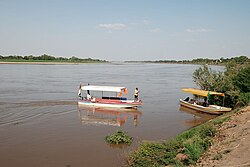Blue Nile Province
|
Blue Nile النيل الأزرق An-Nīl al-Azraq |
|
|---|---|
| State | |
 |
|
 Location in Sudan. |
|
| Coordinates: 11°16′N 34°4′E / 11.267°N 34.067°ECoordinates: 11°16′N 34°4′E / 11.267°N 34.067°E | |
| Country |
|
| Region | Fazogli Province |
| Capital | Ad-Damazin |
| Government | |
| • Governor | Hussein Yassin Hamad |
| Area | |
| • Total | 45,844 km2 (17,700 sq mi) |
| Population (2006 Census - provisional) | |
| • Total | 832,112 |
| Time zone | EAT (UTC+3) |
Blue Nile (Arabic: النيل الأزرق an-Nīl al-ʾAzraq ), called Central (Arabic: الوسطى al-Wustā ) from 1991 until 1994, is one of the eighteen states of the Republic of Sudan. It was established by presidential decree nº 3 in 1992 and is named after the Blue Nile River. It has an area of 45,844 km² and an estimated population of 1,193,293. The Central Bureau of Statistics quoted the population at 832,112 in the 2006 census. Ad-Damazin is the capital of the state. The state of Blue Nile is home to the Roseires Dam, the main source of hydroelectric power in Sudan until the completion of the Merowe Dam in 2010.
The region is host to around forty different ethnic groups. Its economic activity is based upon agriculture and livestock and increasing mineral exploitation.
In 2011, residents of Blue Nile were scheduled to hold ill-defined "popular consultations" to determine the constitutional future of the state, per the Comprehensive Peace Agreement. Instead, a dispute over the rightful government of the state, and the determination of Omar al-Bashir to eradicate the Sudan People's Liberation Movement-North, have led to a renewed insurgency and a refugee crisis. It appears that the consultations have been postponed indefinitely.
The State is sub-divided into six districts (with 2006 Census populations shown hereafter):
...
Wikipedia
